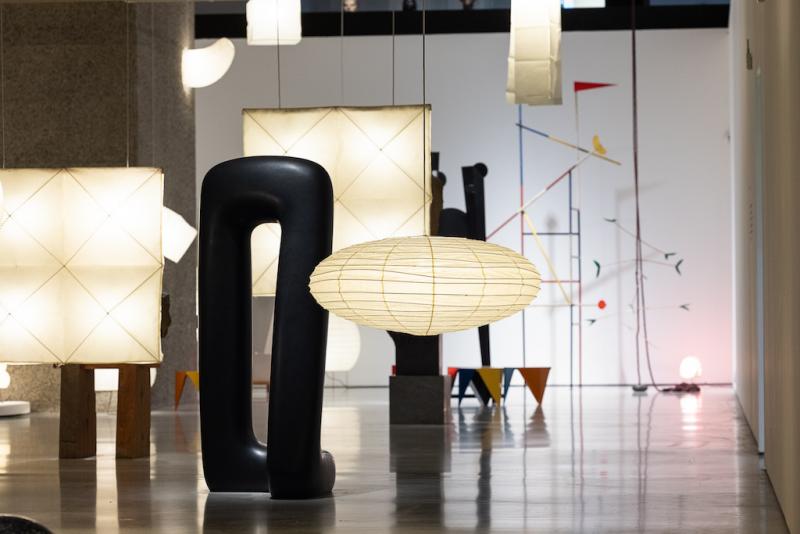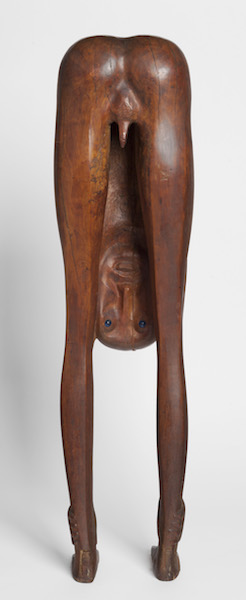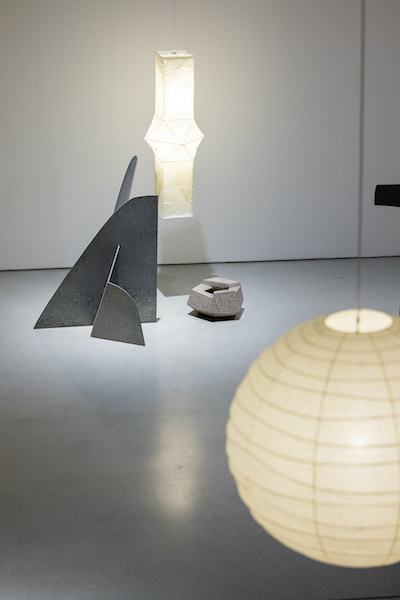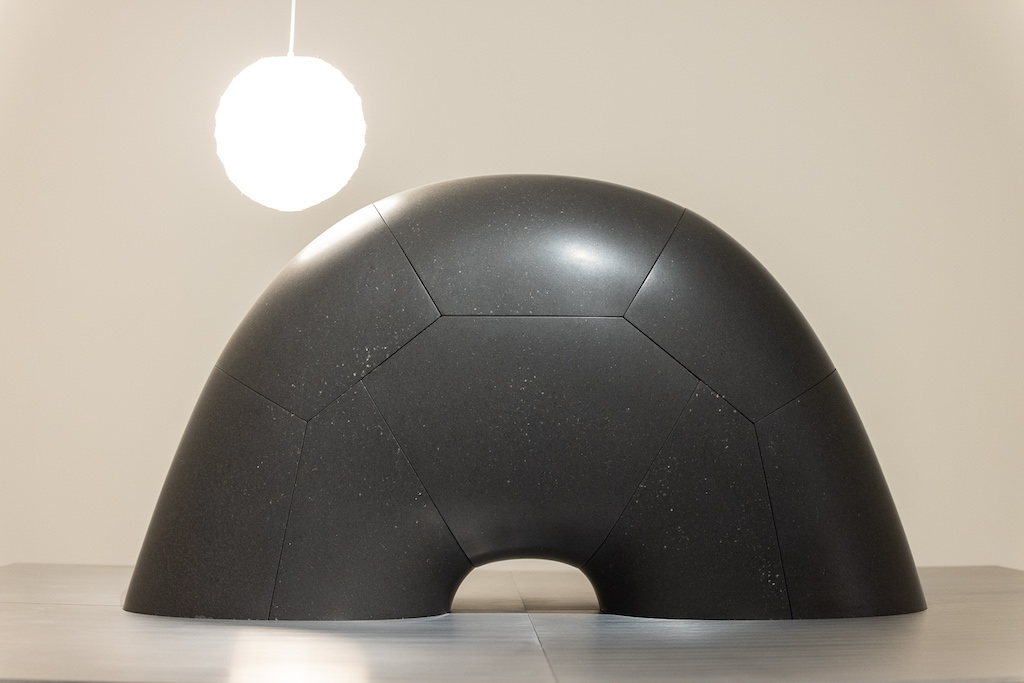Isamu Noguchi, Barbican review – the most elegant exhibition in town | reviews, news & interviews
Isamu Noguchi, Barbican review – the most elegant exhibition in town
Isamu Noguchi, Barbican review – the most elegant exhibition in town
A restless spirit who infiltrated many of our lives

Isamu Noguchi may not be a household name, yet one strand of his work is incredibly familiar. In 1951 he visited a lamp factory in Gifu, a Japanese city famous for its paper lanterns. This prompted him to design the lampshades that, for decades, have adorned nearly every student’s bedsit.
Strips of fine white paper made from mulberry tree bark are glued onto bamboo ribs to create a design that is amazingly versatile and comes in all shapes and sizes. Spheres are the most popular, but Noguchi also designed rectangles, cubes, pyramids, ellipses and columns alongside forms resembling pumpkins, beehives, horns and others too complicated to name.
 He hung them from the ceiling, put them on the floor and rested them on wire stands – treating them, in other words, like sculptural objects. And dotted around the exhibition to illuminate the sculptures, these delightful creatures help create the most beautiful installation the Barbican has ever mounted (main picture).
He hung them from the ceiling, put them on the floor and rested them on wire stands – treating them, in other words, like sculptural objects. And dotted around the exhibition to illuminate the sculptures, these delightful creatures help create the most beautiful installation the Barbican has ever mounted (main picture).
Noguchi wasn’t interested in distinctions between art and design. He made sets for Martha Graham that were integral to the American dancer’s choreography and, wanting to “bring sculpture into a more direct involvement with the common experience of living”, designed a bakelite radio in the shape of a head, a chess set, a coffee table whose glass top rests on sleek black curves, and playgrounds with slides, helter skelters and climbing frames that are essentially outdoor sculptures. And when asked to design plazas for IBM and the Chase Manhattan Bank in New York, he gave them sculptural installations inspired by Japanese gardens.
The artist was born in Los Angeles in 1904 to an Irish American mother and Japanese father and spent his childhood in Japan, returning to the U.S at the age of 13. His dual identity left him feeling a stranger wherever he lived and this confusion is addressed in a comic self portrait (pictured above right). Bent over to peer between his legs, he exposes his arse to the world while seeing everything upside down through piercing blue eyes.
A series of wonderful portraits includes a tender likeness of his uncle, a forceful head of Mexican muralist José Clemente Orozco and a bronze mask of Japanese dancer Michio Ito designed for a No theatre production.
In 1927, he took off for Paris to work for Constantin Brancusi, the doyen of modernism. Heavily influenced by his mentor, he began making gleaming brass abstractions. On his return to the States, though, he met Buckminster Fuller and worked with him on the prototype for an amphibious vehicle. From then on, this dual orientation – towards pure abstraction, on the one hand, and functional design, on the other – continue side by side in his work.
 Noguchi is best known, though, for his abstract sculptures. They come In a wide variety of shapes, sizes and materials ranging from bones and plastic to wood, bronze, stone, ceramic, steel and sheet aluminium painted bright colours. Fascinated by contradictions, he made assemblages from slices of stone so thin they are extremely fragile and a weighty looking sculpture titled Mortality 1959 from balsa, a wood so light that kids use it for making model aircraft. Granite was his favourite stone because of its hardness, yet he burrowed through large blocks of it like a mole, opening up the interior to allow light in while also relishing the polished and rough surfaces of the outside.
Noguchi is best known, though, for his abstract sculptures. They come In a wide variety of shapes, sizes and materials ranging from bones and plastic to wood, bronze, stone, ceramic, steel and sheet aluminium painted bright colours. Fascinated by contradictions, he made assemblages from slices of stone so thin they are extremely fragile and a weighty looking sculpture titled Mortality 1959 from balsa, a wood so light that kids use it for making model aircraft. Granite was his favourite stone because of its hardness, yet he burrowed through large blocks of it like a mole, opening up the interior to allow light in while also relishing the polished and rough surfaces of the outside.
Because of his Japanese heritage, he was interned during WW II in a camp in Arizona. Inevitably, his loyalties were split and his Monument to Heroes 1943, a plastic column pierced by bones, is dedicated to all the pilots he described as “blown by the wind”. He visited Hiroshima in 1951 and, horrified by the devastation caused by the atomic bomb, designed several memorials including Mortality, none of which got built probably because he was an American citizen.
He described bomb sites as an “injury to the earth itself” yet fantasised creating large scale sculptures by dropping bombs. Had he been born later, he might have made earthworks on the scale of Michael Heizer’s Double Negative 1969, a canyon created by moving 244,000 tons of rock. Instead, he contented himself with single pieces that are amazingly powerful. Okame (Atomic Head, Hiroshima Mask) 1954 resembles a face melted by extreme heat to leave a single eye as the only recognisable feature, while the memorial arch he carved in black granite in 1982 (pictured below) is very moving in its dumb solidity, even on this small scale.
 Noguchi died in 1988 having lived though turbulent times. His response was to keep on experimenting, endlessly exploring new materials like plastic, chrome and bakelite only to return to traditional ones like marble, wood, ceramic and bronze. The work keeps changing, he said, “because I change; time changes.” This survey provides fascinating insights into the mind of a restless spirit who infiltrated many of our lives.
Noguchi died in 1988 having lived though turbulent times. His response was to keep on experimenting, endlessly exploring new materials like plastic, chrome and bakelite only to return to traditional ones like marble, wood, ceramic and bronze. The work keeps changing, he said, “because I change; time changes.” This survey provides fascinating insights into the mind of a restless spirit who infiltrated many of our lives.
- Isamu Noguchi is at the Barbican until 9 January 2022
- Read more visual arts reviews on theartsdesk
rating
Share this article
The future of Arts Journalism
You can stop theartsdesk.com closing!
We urgently need financing to survive. Our fundraising drive has thus far raised £49,000 but we need to reach £100,000 or we will be forced to close. Please contribute here: https://gofund.me/c3f6033d
And if you can forward this information to anyone who might assist, we’d be grateful.

Subscribe to theartsdesk.com
Thank you for continuing to read our work on theartsdesk.com. For unlimited access to every article in its entirety, including our archive of more than 15,000 pieces, we're asking for £5 per month or £40 per year. We feel it's a very good deal, and hope you do too.
To take a subscription now simply click here.
And if you're looking for that extra gift for a friend or family member, why not treat them to a theartsdesk.com gift subscription?
more Visual arts
 'We are bowled over!' Thank you for your messages of love and support
Much-appreciated words of commendation from readers and the cultural community
'We are bowled over!' Thank you for your messages of love and support
Much-appreciated words of commendation from readers and the cultural community
 Lee Miller, Tate Britain review - an extraordinary career that remains an enigma
Fashion photographer, artist or war reporter; will the real Lee Miller please step forward?
Lee Miller, Tate Britain review - an extraordinary career that remains an enigma
Fashion photographer, artist or war reporter; will the real Lee Miller please step forward?
 Kerry James Marshall: The Histories, Royal Academy review - a triumphant celebration of blackness
Room after room of glorious paintings
Kerry James Marshall: The Histories, Royal Academy review - a triumphant celebration of blackness
Room after room of glorious paintings
 Folkestone Triennial 2025 - landscape, seascape, art lovers' escape
Locally rooted festival brings home many but not all global concerns
Folkestone Triennial 2025 - landscape, seascape, art lovers' escape
Locally rooted festival brings home many but not all global concerns
 Sir Brian Clarke (1953-2025) - a personal tribute
Remembering an artist with a gift for the transcendent
Sir Brian Clarke (1953-2025) - a personal tribute
Remembering an artist with a gift for the transcendent
 Emily Kam Kngwarray, Tate Modern review - glimpses of another world
Pictures that are an affirmation of belonging
Emily Kam Kngwarray, Tate Modern review - glimpses of another world
Pictures that are an affirmation of belonging
 Kiefer / Van Gogh, Royal Academy review - a pairing of opposites
Small scale intensity meets large scale melodrama
Kiefer / Van Gogh, Royal Academy review - a pairing of opposites
Small scale intensity meets large scale melodrama
 Jenny Saville: The Anatomy of Painting, National Portrait Gallery review - a protégé losing her way
A brilliant painter in search of a worthwhile subject
Jenny Saville: The Anatomy of Painting, National Portrait Gallery review - a protégé losing her way
A brilliant painter in search of a worthwhile subject
 Abstract Erotic, Courtauld Gallery review - sculpture that is sensuous, funny and subversive
Testing the boundaries of good taste, and winning
Abstract Erotic, Courtauld Gallery review - sculpture that is sensuous, funny and subversive
Testing the boundaries of good taste, and winning
 Edward Burra, Tate Britain review - watercolour made mainstream
Social satire with a nasty bite
Edward Burra, Tate Britain review - watercolour made mainstream
Social satire with a nasty bite
 Ithell Colquhoun, Tate Britain review - revelations of a weird and wonderful world
Emanations from the unconscious
Ithell Colquhoun, Tate Britain review - revelations of a weird and wonderful world
Emanations from the unconscious
 Rachel Jones: Gated Canyons, Dulwich Picture Gallery review - teeth with a real bite
Mouths have never looked so good
Rachel Jones: Gated Canyons, Dulwich Picture Gallery review - teeth with a real bite
Mouths have never looked so good

Add comment